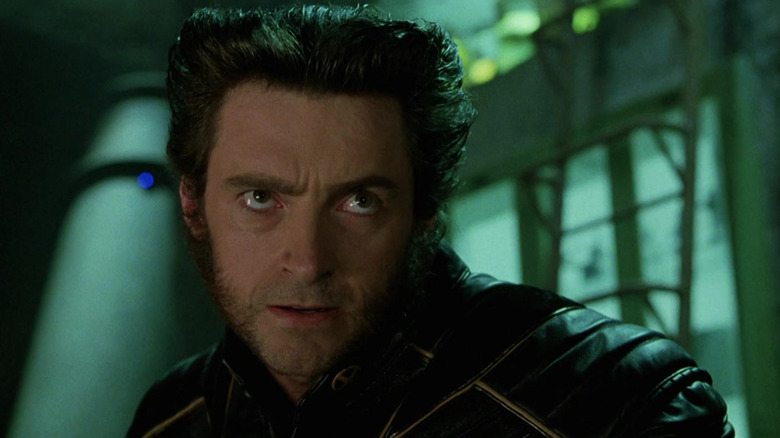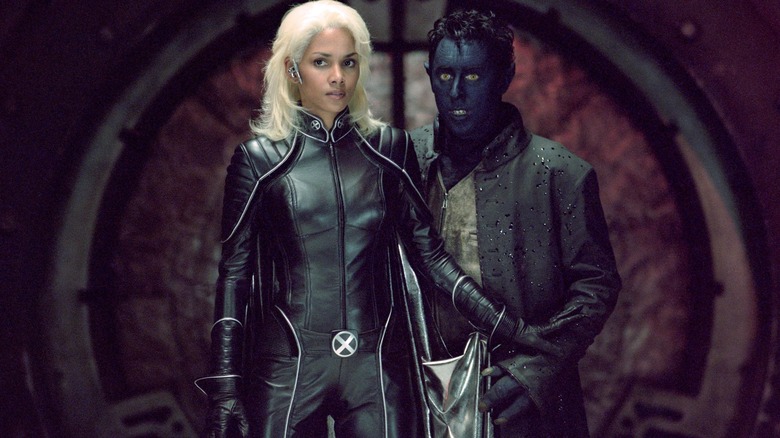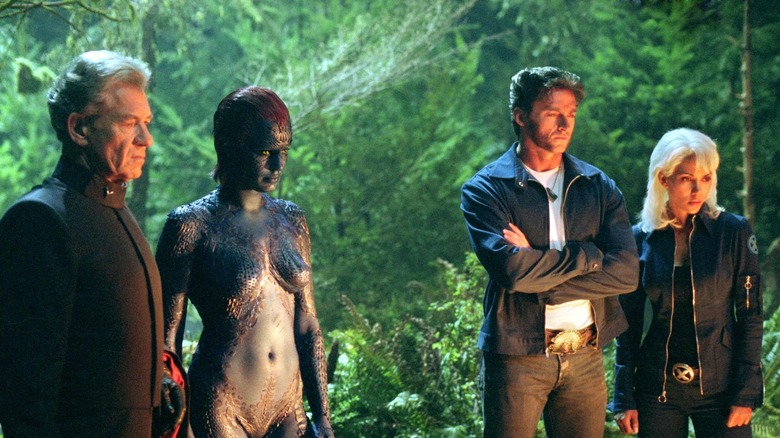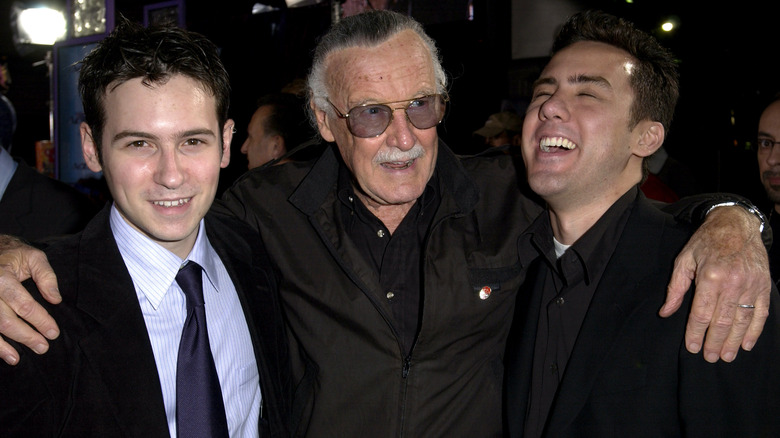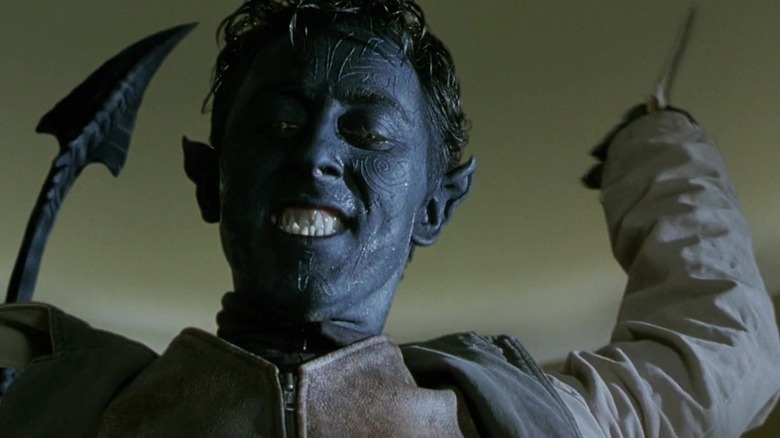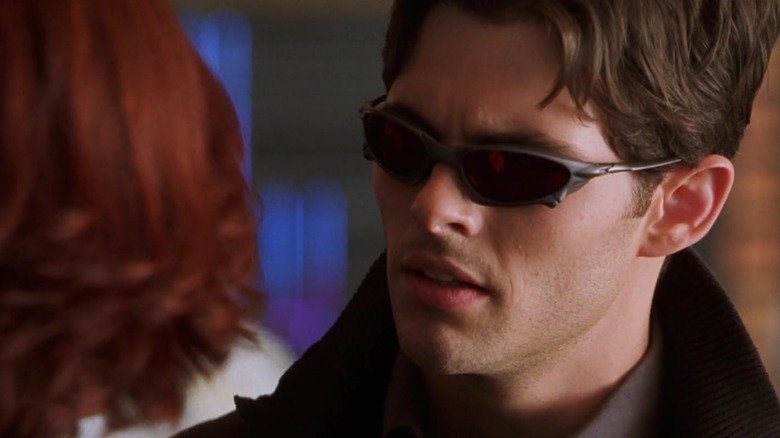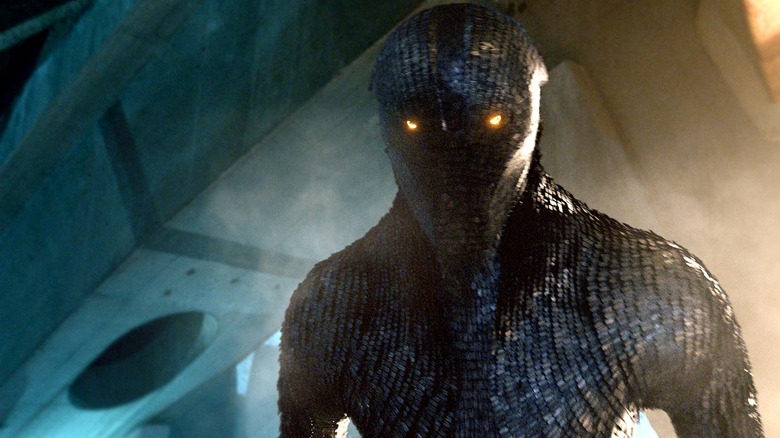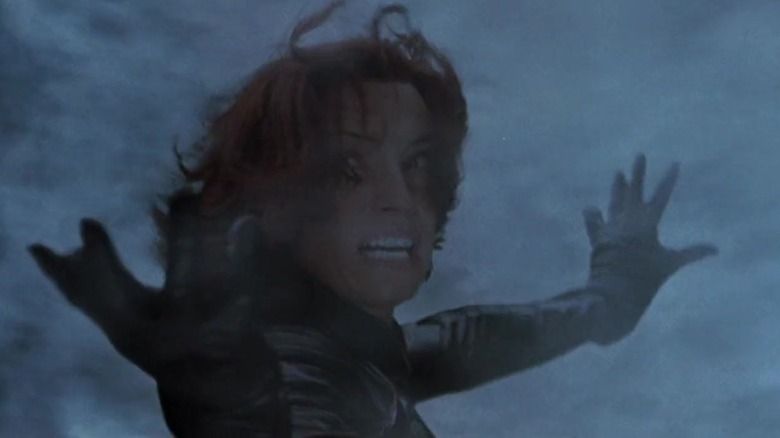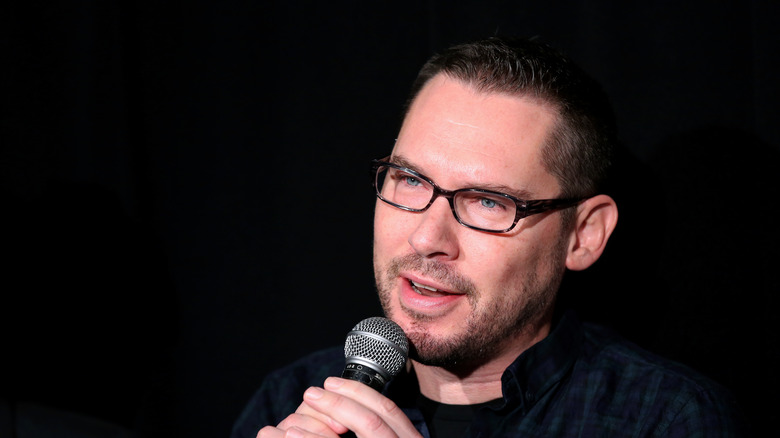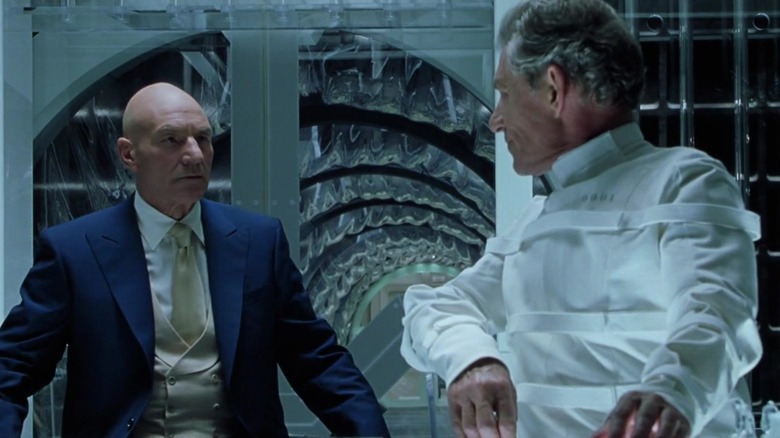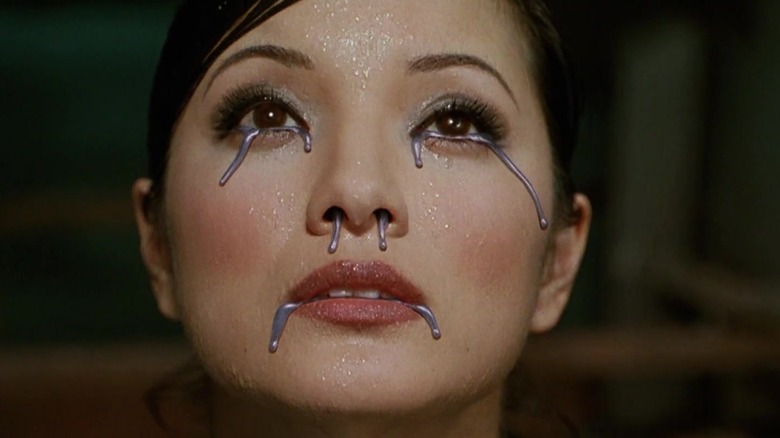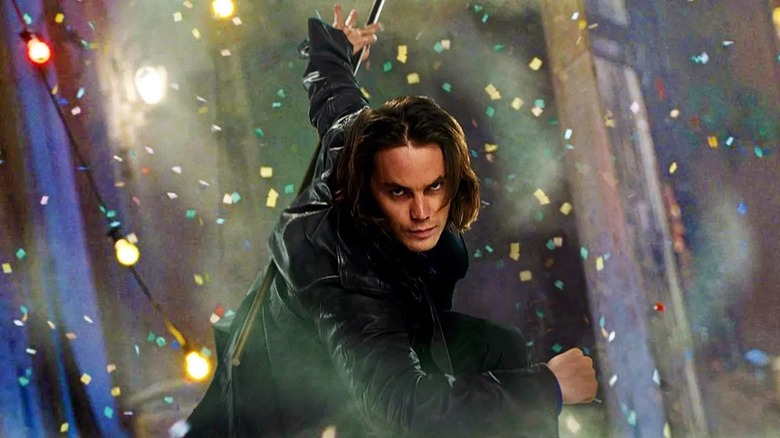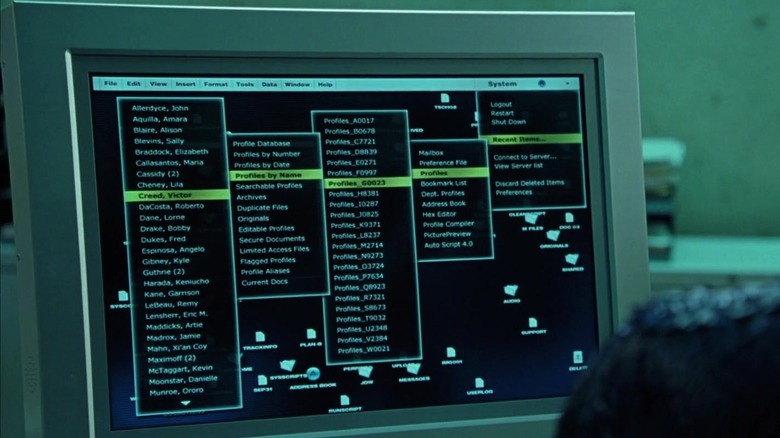Spring Into Action With These X2: X-Men United Facts
Over 20 years of movies, the "X-Men" franchise went everywhere from the far-off future to the R-rated wisecracks of Deadpool (Ryan Reynolds) to even the staples of horror cinema in "The New Mutants." Eventually, this saga became so expansive that it housed a variety of tones and explored many mutant characters from the vast history of the "X-Men" comics. But before all those spin-offs and sequels, the "X-Men" movie franchise had to prove that these merry mutants could sustain more than one motion picture. The nascent franchise's moment of truth came with "X2: X-Men United" in 2003, which brings back the cast of the original "X-Men" feature from 2000 for a new adventure that goes deeper into these characters, their interior lives, and their tragic histories.
Decades after its release, "X2: X-Men United" is still a creative peak of the "X-Men" franchise. Crafting such an iconic superhero film was no easy task, of course. Some elements from the "X-Men" comics mythology were scrapped, some of the film's actors (like Alan Cumming) had tormented experiences on set, and the actors all had to contend with the darker screenplay "X2" has compared to its lighter predecessor. "X2" undoubtedly has a sterling reputation among fans and has retained a great legacy, but how much do you really know about "X2: X-Men United"?
X2 was a significant milestone for Marvel Comics adaptations
Most comic book films these days get sequels. Unless a film bombs spectacularly and its sequel movie is canceled, superhero films are bound to get a follow-up or two. This is especially true for Marvel adaptations, which typically inspire sequels even if the first film doesn't shatter box office records. Titles like "Hulk" and "The Punisher" still saw reboots with new leading men and directors taking the characters in new directions. But the status quo of today wasn't always the norm. Thirty years ago, doing a live-action Marvel Comics adaptation was still a risky concept, associated more with failures like "Howard the Duck" than with improbable hits like "Blade."
The mere existence of "X2: X-Men United" was momentous for comic book movies in general. Sure, "Blade" had led to "Blade II," and "Spider-Man 2" was immediately greenlit after the success of Sam Raimi's first film. The "Men in Black" series, from Marvel imprint Malibu Comics, was similarly a roaring success. But other than those young franchises, no other Marvel Comics adaptation had proved successful enough to inspire a sequel. Made-for-television "Captain America" and "Incredible Hulk" films, pilot films for unsuccessful Nick Fury and Spider-Man series, and the Dolph Lundgren "Punisher" film were really all Marvel had to show for itself before the late '90s.
While DC Comics adaptations like "Superman," "Batman," and even "Swamp-Thing" had resulted in franchises, Marvel hadn't been so lucky. "X2" marked the dawn of a new era of Marvel Comics on film, and there was no going back after this. Soon, "Spider-Man 2" and further "X-Men" sequels proved Marvel Comics adaptations had blockbuster franchise potential. And for pop culture, the films made Marvel characters as popular as the Dark Knight or the Man of Steel.
X2 was greenlit only days after X-Men was released
"X2: X-Men United" arrived just three years after its predecessor, a quick turnaround that can be chalked up to how quickly this movie was greenlit. The studio, 20th Century Fox, gave the sequel the go-ahead before the first film's opening weekend was even finished. The positive audience response to that inaugural live-action take on the mutants, not to mention the $54 million opening weekend, was enough to make studio execs confident enough in the idea of an "X-Men" franchise. The franchise, including spin-offs, has grossed over $6 billion worldwide.
Though "X2" was quickly put into production, it took much longer to actually get the star-studded ensemble reunited for another "X-Men" movie. It's one thing to commission a script for a second "X-Men" title, but it's another to have in-demand performers like Ian McKellen, Halle Berry, and Patrick Stewart back on the set in costume. However, by the time the fall of 2001 arrived, the studio was finally able to schedule all these actors to reunite for "X2." It was immediately clear to 20th Century Fox that "X-Men" was going to inspire sequels, but due to the busy schedules of the franchise's actors, it took a little longer to make those plans a reality.
Michael Dougherty and Dan Harris had an unusual time writing the X2 screenplay
Before he directed major motion pictures like "Krampus" or "Godzilla: King of the Monsters," Michael Dougherty was largely known as a screenwriter. In his time working as a writer-for-hire, Dougherty co-wrote the script for "X2: X-Men United" alongside Dan Harris. The script was based on earlier drafts from David Hayter and Zak Penn. Dougherty explained to ComicBookMovie.com in 2003 that his experience writing "X2" was much different than other normal screenwriting gigs. For one thing, there were apparently countless drafts delivered for director Bryan Singer. "We turned in hundreds of drafts just to Bryan," Dougherty said. "He's so involved in the story and the development of the screenplay that we were giving him a new script [with] a couple of drafts every week."
Dougherty also said Singer fostered an unorthodox creative environment that was meant to replicate the collaborations between writers and directors that shaped classic Hollywood. "Sometimes [Singer] would sit there with us for 12 hours reading the script line by line," Dougherty said. Harris estimated that while they turned in 26 unique drafts to the studio, they generated about 150 for the creative team alone. Dougherty and Harris said they developed a good rapport with the major "X2" players that they even got to be on the film's set on a nearly daily basis and attended every production and post-production meeting. "We sat in on every kind of meeting, from visual effects to the budget to all that because everything affects the script," Harris said.
Alan Cumming did not have a good time playing Nightcrawler
In "X2: X-Men United," Nightcrawler leaps off the pages of comic books and into the world of live-action cinema. Alan Cumming, a Scottish actor then known for stage acting and for small roles like in the "Spy Kids" series, was tasked with bringing this transition to life, and he delivers a performance that's instantly recognizable as Nightcrawler from the comics while also being engaging on its own terms. This outstanding work, unfortunately, was not further seen in later "X-Men" installments. Cumming never reprised the role of Nightcrawler in subsequent "X-Men" movies, a strange detail given how many figures of this franchise have shown up in multiple installments.
A key reason for his absence from later "X-Men" installments was Cumming's dreary experience playing Nightcrawler in "X2." Talking to the White Wine Question Time podcast, Cumming said the "X2" set was "dangerous" and "abusive." He said the actors' complaints about the working environment fell on deaf ears at the studio. He said he felt "dirty about going to work." He said he was stuck under heaps of blue makeup and drank wine and cried every night, being in an incredibly volatile emotional state while shooting the feature. The experience put Cumming off of working in the world of blockbuster movies ever again. Considering the traumatic experiences he endured on the set, it's no wonder "X2: X-Men United" was the only time Cumming showed up in live-action features as Nightcrawler.
James Marsden and Famke Janssen didn't feel much pressure making X2
"X2: X-Men United" is James Marsden's second go-around portraying Scott Summers aka Cyclops, one of the leading members of the X-Men team. Coming off a surprise hit like the 2000 movie "X-Men," one might imagine that Marsden was a bit panicked over the idea of trying to match newly heightened audience expectations. However, Marsden said he was actually in a relaxed state of mind while filming this blockbuster feature — or at least as relaxed as one can be when filming elaborate action sequences.
James Marsden and Famke Janssen told Comic Book Resources that there was pressure to live up to the first "X-Men" but that the filmmakers felt it more than the stars. For Marsden, being on the set of "X2" was an exciting experience, since he got to reunite with actors he loved yet hadn't worked with in a while. The entire group of performers from the original "X-Men," with no notably absent performers, made this reunion feel extra special. Plus, he said, the success of the initial "X-Men" movie allowed the cast a chance to explore their characters more.
If there was any pressure on the actors, it was from not knowing where the story was headed. Marsden's experiences on set back up the screenwriters' reports that the film's script was always changing. "When we were shooting it, it was constantly reworked," he said, "dramatically at times."
The Sentinels and Danger Room were cut from X2
Though the X-Men were coming to live-action for the first time with the movies "X-Men" and "X2: X-Men United," that didn't mean every element of the group's lore would be getting translated into the films. For the confines of a two-hour movie, not everything from decades of comic book adventures could be squeezed in. Two notable examples of this from the first two "X-Men" installments were the Danger Room and the Sentinels. The Danger Room is a training site for the X-Men, while the Sentinels are powerful anti-mutant robots that function as some of the group's most powerful foes.
Vividly designed concept art makes it clear that the Sentinels and Danger Room were both originally supposed to factor into "X2: X-Men United." However, for a multitude of reasons (including simple budgetary restrictions), neither the training room nor the mutant-killing robots appear in "X2." Instead, the Danger Room is finally shown in the sequel, "X-Men: The Last Stand." Within the training space, the head of a Sentinel can be seen, though it took until "X-Men: Days of Future Past" for these robotic adversaries to be seen in full.
Famke Janssen was not a fan of all the green screen work on the X2 set
Inevitably, many actors accustomed to working on traditional films — especially indie productions — will find themselves more than a tad frustrated if they take on a role in a major summer blockbuster. In this domain, actors tend to work on green- or blue-screen soundstages, with digital environments added later. It's a common practice for big-budget features, but that doesn't make it any easier for the actors, many of whom have to interact with absolutely nothing while still trying to perform. Famke Janssen, the performer behind Jean Grey in "X2: X-Men United," found herself struggling with this on the set of "X2."
Janssen told the BBC, "I did have to do a lot more green screen this time, which is a bit of a problem because you are acting on your own." But she also said that working on the first film prepared her — and the entire cast — for a very special effects-driven production. "We didn't know what we were in for with the first film, because you just read all the special effects and you read the action sequences and you had no idea what it was going to look like in the end," she said. "This time, we all went back in with much more confidence and we knew what the tone of the movie was." While she might not have loved working with so much green screen, Janssen said she loved getting to inhabit and explore the darker side of Jean Grey.
Director Bryan Singer's alleged toxic behavior on the X2 set forced the actors to confront him
Unfortunately, the original "X-Men" movies are pretty inseparable from director Bryan Singer, who was a key creative voice on the first live-action incarnations of these mutants. He directed the first two films as well as "X-Men: Days of Future Past" and "X-Men: Apocalypse" and produced several other films in the franchise. Singer is also mired in countless allegations of inappropriate behavior toward minors, including allegations of infliction of emotional distress, negligence, invasion of privacy, and sexual assault. He has not been charged, and all of these cases were either dismissed or settled out of court. These horrific allegations are joined by assertions that Singer engages in hostile on-set behavior towards his cast and crew. Jennifer Lawrence openly joked about his toxic on-set behavior in 2022. Unsurprisingly, Singer's alleged streak of inappropriate behavior was also reported during the making of "X2: X-Men United."
The most infamous of these alleged incidents was detailed by The Hollywood Reporter in 2020, with the outlet that Singer engaged in disruptive behavior during filming, including taking inhibitive narcotics. Singer's behavior resulted in a tumultuous and dangerous shoot for a stunt-heavy scene featuring the X-Men's jet. Hugh Jackman was injured in the stunt and bled, and the production was halted. That, combined with the potential impending loss of producer Tom DeSanto (who reportedly tried to curb Singer's power), inspired the "X2" cast to stage an intervention with Singer. The alleged confrontation was apparently very hostile, with Halle Berry being especially frustrated by Singer's actions and his response to being called out on them. In the end, even after this alleged event, Singer stayed on as the director of "X2," with this anecdote becoming yet another chilling allegation of the filmmaker's behavior during his time making "X-Men" movies.
If you or someone you know may be the victim of child abuse, please contact the Childhelp National Child Abuse Hotline at 1-800-4-A-Child (1-800-422-4453) or contact their live chat services.
Patrick Stewart and Ian McKellen had no clue how to play chess
Patrick Stewart and Ian McKellen seem capable of anything that a screenplay throws at them. If you want Stewart to go out on stage and recite William Shakespeare to massive crowds of people, he can do that. If you want him to lend real gravitas to a sci-fi series like "Star Trek: The Next Generation," no problem. The same can be said for the incredible McKellen, another man capable of nailing any role he accepts, be it a stage performance or "The Lord of the Rings." These men are incredibly versatile performers, but for their second go-around in the "X-Men" franchise, both Stewart and McKellen had to confront a massive shortcoming.
Talking to Blackfilm, Stewart recalled that a scene in the "X2" script called for Xavier to play chess with former friend Erik Lehnsherr (McKellen), an endeavor that put this thespian in a cold sweat. It turned out Stewart couldn't play! Luckily, McKellen was also oblivious as to how to play the game, so a Canadian grandmaster was called to set for the day just to ensure that Stewart and McKellen looked like chess pros on camera. "I told him, you are so overqualified for this job," Stewart said. "[The chess consultant] said, 'I've never been on a set before.' And he stayed all day." Stewart and McKellen can do nearly anything, but their struggles with chess show that even these legend have their limits.
X2 almost scored an R rating
Late in the franchise's lifespan, the "X-Men" saga became well-known for its R-rated installments. The 2016 film "Deadpool" blew the door wide open on mainstream R-rated superhero titles, while the following year's "Logan" solidified that the franchise could do dramatic R-rated stories as well. The "X-Men" movies got so comfortable with R-rated features that even Channing Tatum's planned Gambit movie was planned to be rated R. However, long before any of these movies opened in theaters, there was initially way more hesitation over allowing R-rated "X-Men" titles. Just ask the producers of "X2: X-Men United."
Producers Ralph Winter and Lauren Shuler Donner explained to Comic Book Resources in 2003 that "X2: X-Men United" never got an official R rating from the MPAA, but the filmmakers did have to trim down some violence to secure the movie a PG-13 rating. Notably, the feature had to dial back on the blood in certain hand-to-hand fight scenes, since the presence of gore jeopardized the movie's PG-13 rating. "We have two characters that have claws," Winter said. "At some point they're gonna fight. [...] So for us it was about the intensity of that. It was about the blood, which we tried to hold back on, because that's what really pushes it over the edge and makes it unnecessarily gory." After editing down the brutality of the fight scenes, the filmmakers avoided an R rating. But as 20th Century Fox learned with "Deadpool" and "Logan" over a decade later, audiences are willing to show up for gory, R-rated "X-Men" films.
Fans almost got to see Gambit in X2
Gambit has proven to be one of the most enduring and popular members of the X-Men for comic book readers across the globe, but that popularity hasn't translated into a surplus of live-action appearances from this mutant. In fact, Gambit has only shown up in the "X-Men" film franchise once, through a small role in "X-Men Origins: Wolverine," where he's played by Taylor Kitsch. For years, plans were brewing for a solo feature for Gambit headlined by Channing Tatum, but this never came to pass. Though Gambit's been strangely absent on the big screen, that doesn't mean there haven't been various attempts to bring him into the "X-Men" films.
Stuntman James Bamford revealed to Mania Movies in April 2003 that he portrayed Gambit in a cameo role in "X2: X-Men United" that was ultimately left on the cutting room floor. Bamford's casting was apparently quite sudden and revolved entirely around this performer's looks being just right for the part. Bamford, who was a stunt double for Wolverine (Hugh Jackman) during rehearsals before nabbing the Gambit role, said, "The scene that I was involved in as Gambit took only one day to shoot. It was a very small part, a cameo. There are no photos that I have from the film to give out, sorry. I did not do any screen test or audition." This deleted cameo is yet another frustrating bump in Gambit's tumultuous journey from the pages of comic books onto the big screen.
X2 crammed a bunch of mutants into one Easter egg
"X2: X-Men United" delivers a whole basket of Easter eggs at once in a blink-and-you'll-miss-it shot. When Mystique (Rebecca Romijn) is exploring Col. Stryker's (Brian Cox) computer, she clicks through oodles of files related to many mutants from across "X-Men" lore.
Die-hard "X-Men" fans can spot all kinds of names flashing on the screen here, including Danielle Moonstar aka Psyche, later seen played by Blu Hunt in "The New Mutants." There are also two Maxmioffs listed — the Maximoff twins played in the MCU by Aaron Taylor-Johnson and Elizabeth Olsen — alongside Jamie Madrox aka Multiple Man, Keniucho Harada aka Silver Samurai, and Remy LeBeau aka Gambit. Multiple Man is later seen in "X-Men: The Last Stand," played by Eric Dane, while the studio later tried for years to get a James Franco-led "Multiple Man" film off the ground to no avail. Silver Samurai, meanwhile, later appears as a villain in "The Wolverine."
